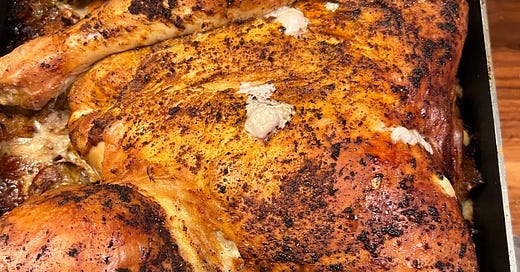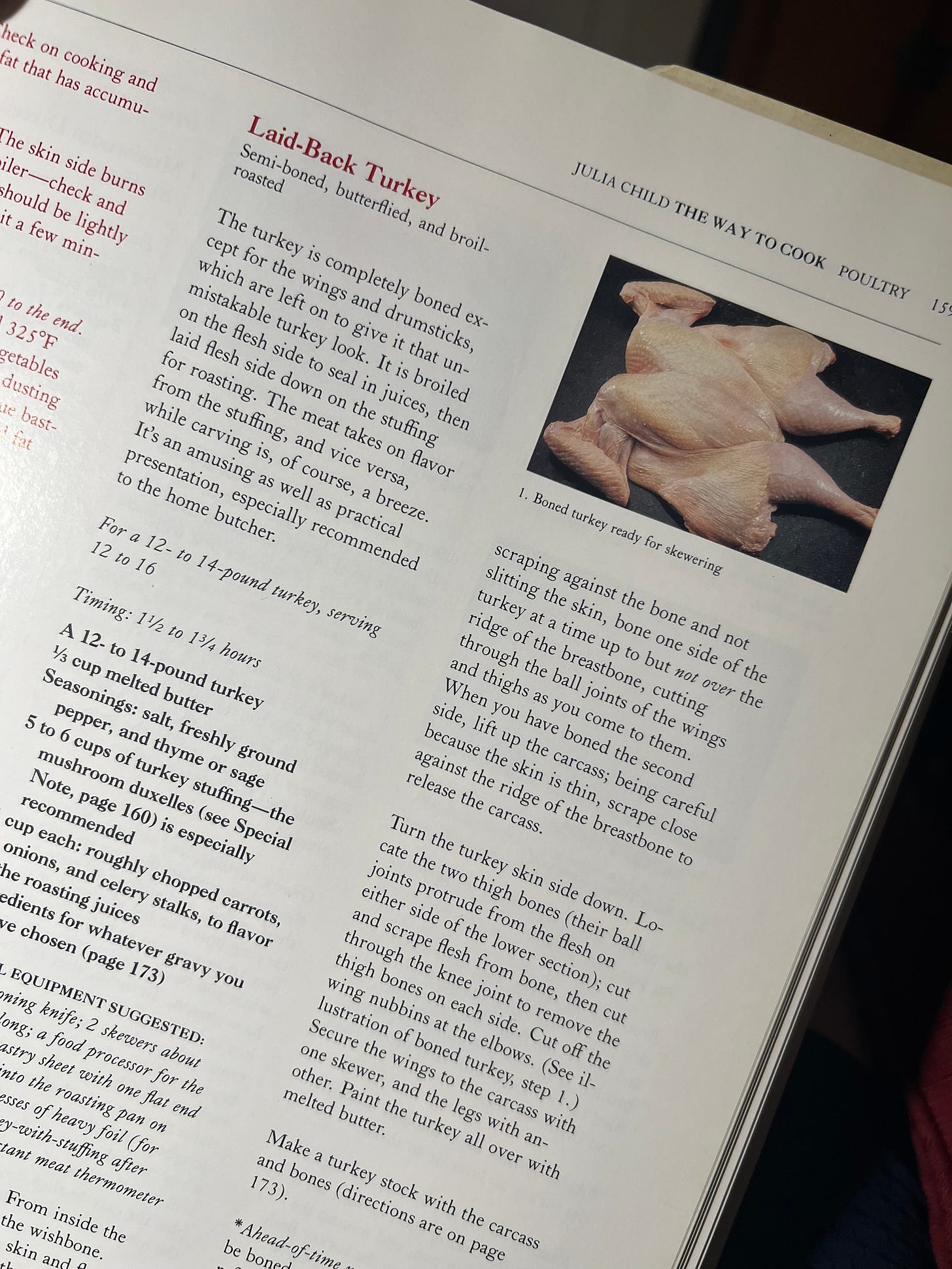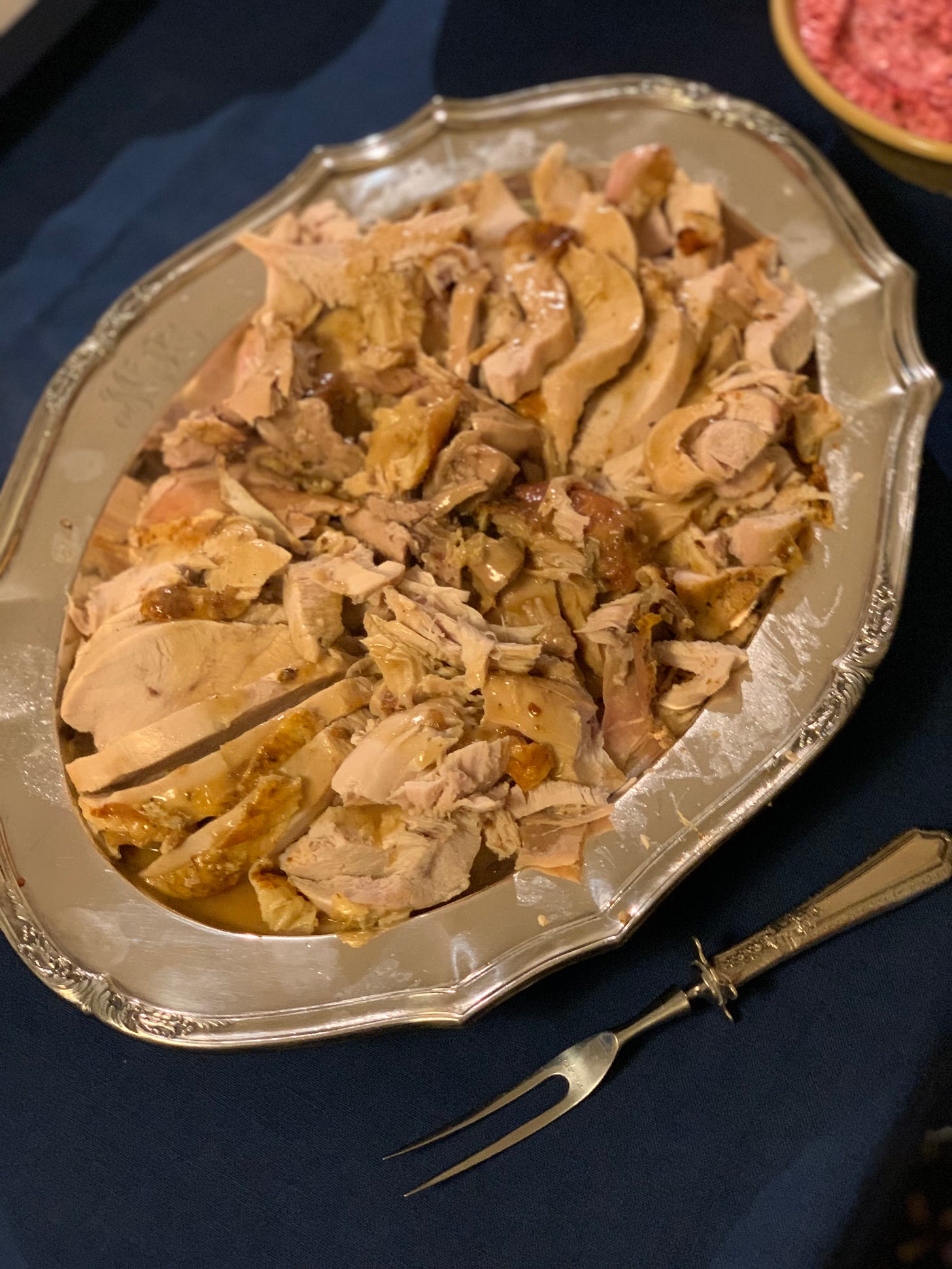Issue #129: Roasted Turkey in No Time, Flat
Spatchcock Your Bird Already, Your Stuffing Will Thank You
So much horrible stuff going on in the world right now (and always). It’s nice to have a day with family and friends to focus on the things we are thankful for. Happy Thanksgiving! —Mitchell
It’s that time of year again. Turkey day is tomorrow in the United States of America. For many, Thanksgiving dinner is the only full meal they cook all year. And it’s such an important one that they want to get it right. Alas, so many get it wrong.
The hardest part for most is timing. In addition to there being so many different things you have to figure out how to have ready at the same time—a challenge for even the most experienced cooks—your oven is taken up for hours by a large bird. I was just with a friend who’s a very good cook who said she wasn’t sure how she was going to make Thanksgiving this year because her new kitchen only had one oven. I’ve only ever had one oven. The concept of two never even entered my mind.
In addition to making sure you have some side dishes that can be cooked on the stove, some, perhaps, on the grill, maybe even others you can reheat in the microwave, here’s a nifty piece of advice you should deploy:
Spatchcock your turkey.
To spatchcock means to flatten the bird, which you do by removing the backbone, cracking or removing the wishbone, and pressing down firmly so the turkey literally flattens. You can flatten the leg and thigh at the joints, too, if they stick up. You can spatchcock chickens, or any bird, for that matter. Flattened, they cook more evenly and more quickly, especially if roasted or grilled. For example, a 15-pound turkey might take 4 hours to roast whole (make sure you’ve fully defrosted it first). The same bird spatchcocked will cook in about 90 minutes. This frees up your oven both because a flattened bird takes up less space and because the whole thing takes less time. What’s more, the meat cooks more evenly, so the breast meat is moist and the dark meat is less stringy.
A Word about the Word
According to the Oxford Companion to Food, “spatchcock” likely originates in Irish usage in the late 18th century, when it meant similarly to flatten a bird and grill it. They suggest it is likely a contraction of the phrase “dispatch cock,” (kill the bird?). You could also just call it “butterflied.” Whatever. Do it.
Here’s another thing, if you roast the turkey over your stuffing, all—and I mean ALL—of the juices soak into it. “Juices” is a cooking euphemism for fat and blood, the things that give meat—and stuffing, it turns out—flavor. You don’t have to worry as much about food borne illness as you do when you stuff the cavity of a whole-roasted turkey because the stuffing uniformly heats to temperatures outside the danger zone. In fact, it usually gets darkly browned and extra crisp around the edges, an added bonus. As a result, the stuffing is so delicious you could die (and you might from all that excess fat, but hey, it’s only once a year).
Funnily enough, in 2005, when my Canadian food guru friend Bonnie Stern asked me for advice about a recipe for Canadian Thanksgiving to write about in her weekly column. I suggested she spatchcock the turkey. I had been flipping through Julia Child’s seminal The Way To Cook (written in 1989), and noticed her “Laid Back Turkey,” for which she spatchcocked the bird and, you guessed it, roasted it on top of her stuffing. Mark Bittman later popularized the spatchcocking technique when in 2002 he wrote about a 45-minute turkey in his “Minimalist” column in the New York Times. Bonnie took my suggestion to heart, tested the technique, published a recipe, and has been making turkeys this way ever since.
I’ll note, I’d never spatchcocked a turkey at the time I suggested Bonnie give it a try. I was still roasting my turkeys whole in the oven, the bird jockeying for space with baking dishes of stuffing and casseroles of green beans.
Years later, a decade to be exact, in 2015, I asked Bonnie to remind me how she spatchcocked her turkey. I knew it was her preferred technique. This was her email reply at the time: “I have been doing this since 2005 when you showed me Julia Child’s laid back turkey recipe.” Funny, I’d forgotten it was my suggestion.
Still, it took me until last year when I actually spatchcocked my own Thanksgiving turkey. The result was undeniably delicious in no time, flat.
What had I been waiting for? I think we all have a Norman Rockwell image in our minds of everyone gathered around a Thanksgiving table when a whole-roasted, golden-brown bird is presented to father to carve. It didn’t deter us when we learned that the turkeys presented thusly in the seasonal commercials were probably raw, artificially colored, and shellacked by food stylists. I’ve never served a turkey whole this way in the dining room. I carve in the kitchen, so the mess stays behind. Still the image prevails. It shouldn’t.
I think we also are a bit invested in the endless cooking of the bird and the chaos in the kitchen that is a feature of so many family Thanksgivings the frenetic feeling is almost as much a part of the tradition as anything else. (See The Bear, Season 2, Episode 6, “Fishes” for the Christmas equivalent of what I mean.) It shouldn’t be.
Two Notes
I’ve never been a fan of wet brining turkey because it’s awkward to handle a giant bird in a bath and it changes the texture of the meat in a way I don’t love. My advice has always been to just not overcook it. When it comes to spatchcocking, brining is overkill, and if you are roasting the turkey over stuffing, it can make the result unpleasantly oversalted. Instead, season your turkey in advance with salt and a favorite rub of spices, and let it marinated in the fridge until you are ready to cook it.
As for the stuffing, I’m not going to give you a recipe here. Most people have a family favorite. What I’ll say is that if your recipe fills a 2-quart casserole dish, you’ll need a double batch to make a nice bed for your bird. And don’t go thinking this will be too much stuffing because it is doubly delicious this way and the whole lot will be eaten.
RECIPE: Spatchcock Roasted Turkey on Stuffing
One 15-pound turkey, defrosted
¼ cup olive oil
1 tablespoon kosher salt
2 teaspoons smoked paprika
1 teaspoon garlic powder
1 teaspoon freshly ground black pepper
A double batch of your family’s favorite stuffing, uncooked
To spatchcock the turkey, on a large cutting board or sheet pan, stand the bird up on its shoulders, feet in the air, breasts facing away from you. Using a sharp knife with a sturdy blade, cut along both sides of the back bone, through the bones, from the tail to the neck, to remove spine. Lay the turkey cut side down and spread the two halves of the bird apart by pushing down with all your weigh onto the breast. You should feel and hear a crack of the wishbone to know you’ve really flattened it. Alternately, you can remove that wishbone from the neck side of the breast with a sharp boning knife before you flatten the bird. Your goal is something that looks a little like it was run over by a car. Place it on a baking sheet.
Rub the skin of the turkey with the olive oil and season it with the salt, paprika, garlic powder, and black pepper. Set the turkey in the refrigerator for a couple of hours or overnight.
Preheat the oven to 425°F. Place the stuffing in the bottom of the large roasting pan. Lay the turkey on top of the stuffing. Place the roasting pan in the preheated oven and roast until the bird is nicely browned, and an instant-read thermometer inserted into the breast and thigh reads at least 160°F. If the skin or the stuffing begin to brown too much, reduce the oven temperature to 375°F, cover with foil, and continue roasting until it reaches the right temperature. Remove from the oven, cover loosely with aluminum foil, and let sit about 15 minutes before you carve.






